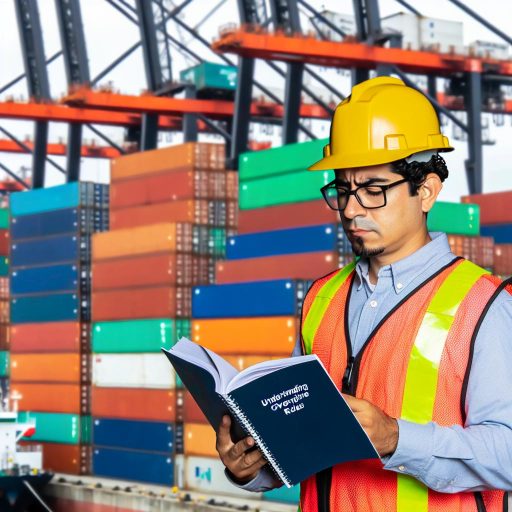Introduction:
Effective communication in warehouse management is crucial for seamless operations.
It improves efficiency, reduces errors, and enhances overall productivity.
Clear Communication Channels:
In warehouse management, effective communication is key to ensuring smooth operations, timely deliveries, and overall efficiency.
Without clear communication channels, misunderstandings can arise, leading to costly errors and delays.
Here are some ways to ensure effective communication in warehouse management:
Establishing Clear Lines of Communication:
One of the first steps in promoting effective communication in warehouse management is to establish clear lines of communication.
This includes having designated channels for different types of communication, such as verbal, written, and digital.
By clearly outlining how information should be communicated and to whom, you can prevent confusion and misunderstandings.
Utilizing Technology:
Another way to enhance communication in warehouse management is by leveraging technology.
Communication apps and systems can streamline processes, provide real-time updates, and facilitate quick decision-making.
Implementing tools like instant messaging platforms, inventory tracking systems, and electronic data interchange (EDI) can help employees communicate efficiently and stay informed about the status of operations.
Ensuring Employee Understanding:
Effective communication is not just about having the right tools; it also involves ensuring that all employees understand how to communicate effectively.
Providing training on communication best practices, emphasizing the importance of clear and concise messaging, and encouraging open dialogue can help create a culture of effective communication within the warehouse.
Regular feedback sessions and communication audits can also help identify areas for improvement and address any communication gaps.
By establishing clear communication channels, utilizing technology, and ensuring employee understanding, warehouse managers can improve overall productivity, reduce errors, and enhance customer satisfaction.
Effective communication is a cornerstone of successful warehouse management and should be prioritized in daily operations.
When it comes to effective communication in warehouse management, the role of leadership is vital for success.
Here are some key aspects of how leaders can play a significant role in enhancing communication within the warehouse:
The Importance of Leaders Setting Communication Standards
- Leaders should establish clear communication protocols and expectations for all team members to follow.
- Setting standards ensures that everyone is on the same page and understands how to communicate effectively.
- Consistent messaging from leadership helps create a cohesive and transparent communication culture.
Providing Training on Effective Communication Strategies
- Leaders should invest in communication training for managers and staff to improve their skills.
- Training can include active listening, conflict resolution, and interpersonal communication techniques.
- By equipping team members with the right tools, leaders empower them to communicate more effectively.
Encouraging Open Communication and Feedback
- Leaders should foster an environment where team members feel comfortable sharing their thoughts and ideas.
- Encouraging open communication helps prevent misunderstandings and promotes collaboration.
- Feedback mechanisms should be in place for employees to provide input on communication practices.
The role of leadership in effective communication within warehouse management cannot be understated.
By setting standards, providing training, and encouraging open communication, leaders can create a culture of clear and effective communication that contributes to the overall success of the warehouse operations.
Transform Your Career Today
Unlock a personalized career strategy that drives real results. Get tailored advice and a roadmap designed just for you.
Start NowExplore Further: Top Challenges Faced by Ironworkers in Construction
Team Collaboration:
Encouraging teamwork and collaboration through effective communication is essential in warehouse management.
Without proper communication, teams can face challenges that may hinder their productivity and efficiency.
- Holding regular meetings to discuss progress and address any issues is crucial. This allows team members to stay informed and aligned with the goals of the warehouse.
- Creating a positive and supportive communication environment fosters a sense of unity among team members. When employees feel heard and valued, they are more likely to collaborate effectively.
Team collaboration is not just about working together, but it also involves effective communication strategies that promote transparency, trust, and accountability within the team.
Here are some key ways to enhance team collaboration through communication:
- Open Lines of Communication: Encourage team members to communicate openly and honestly with each other. This creates a transparent work environment where issues can be addressed promptly.
- Empowerment: Give team members the autonomy to make decisions and take ownership of their work. This boosts morale and motivates employees to collaborate more effectively.
- Clear Expectations: Set clear goals and expectations for team members to follow. When everyone is on the same page, collaboration becomes more streamlined and efficient.
- Feedback Mechanisms: Establish feedback channels for team members to provide input and suggestions. Feedback is essential for continuous improvement and fosters a culture of learning within the team.
- Conflict Resolution: Address conflicts in a timely and constructive manner. Encourage open dialogue and mediation to resolve conflicts before they escalate and impact team collaboration.
Effective communication is the backbone of team collaboration in warehouse management.
By implementing these strategies, warehouse managers can create a harmonious and productive work environment where teams can work together seamlessly to achieve common goals.
You Might Also Like: A Day in the Life of a Professional Drywall Installer
Consistent Updates:
Consistent updates play a crucial role in effective communication in warehouse management.
By providing regular updates on inventory levels, order status, and other critical warehouse information, you can ensure that everyone in the team is well-informed and aligned with the goals and expectations of the warehouse operations.
One of the key benefits of consistent updates is the ability to keep everyone on the same page.
When all team members are aware of the latest developments, they can work together more efficiently towards common objectives.
This transparency helps in fostering a collaborative work environment where everyone understands their roles and responsibilities.
Moreover, consistent updates help in avoiding miscommunication.
When information is shared regularly and openly, there is less chance of misunderstandings or confusion among team members.
By keeping everyone informed, you can prevent errors and delays in warehouse operations, ultimately leading to improved productivity and customer satisfaction.
To ensure effective communication through consistent updates, it is essential to establish clear channels of communication within the warehouse management team.
Utilize tools such as email, messaging apps, or weekly meetings to share updates on inventory levels, order status, and any other pertinent information.
Encourage open communication and feedback to address any concerns or questions that may arise.
Consistent updates are vital for effective communication in warehouse management.
Transform Your Career Today
Unlock a personalized career strategy that drives real results. Get tailored advice and a roadmap designed just for you.
Start NowBy providing regular information and keeping everyone informed, you can enhance teamwork, prevent misunderstandings, and optimize operational efficiency.
Make it a priority to communicate consistently with your team to foster a productive and harmonious work environment in the warehouse.
You Might Also Like: Dockworker’s Role in Port Security and Safety
Active Listening:
Effective communication in warehouse management goes beyond just speaking. It involves active listening.
By actively listening to team members, managers can better understand their needs and concerns.
Training employees on active listening techniques is crucial for improving communication within the warehouse.
This can include strategies such as maintaining eye contact, nodding to show understanding, and summarizing what was said.
Encouraging feedback and suggestions from all team members is essential for creating an open and collaborative work environment.
This communication style fosters trust and builds stronger relationships among colleagues.
By incorporating active listening into warehouse management practices, managers can enhance communication effectiveness.
This leads to a more cohesive team. Active listening is a skill that can be developed and refined over time.
It results in improved overall warehouse performance.
- Emphasizing the importance of listening in effective communication
- Training employees on active listening techniques
- Encouraging feedback and suggestions from all team members
See Related Content: Top Skills Needed for Success as a Maintenance Worker

Conflict Resolution:
- Addressing conflicts or misunderstandings promptly and effectively
- Implementing strategies for resolving disagreements or issues
- Mediating disagreements and finding solutions that benefit all parties involved
In any warehouse management setting, conflicts and disagreements among team members are bound to arise.
It is crucial to address these issues promptly and effectively to maintain smooth operations and foster a positive work environment.
Addressing conflicts or misunderstandings promptly and effectively
When a conflict or misunderstanding arises in the warehouse, it is essential to address it as soon as possible.
Ignoring the issue or allowing it to escalate can lead to decreased productivity, low morale, and a toxic work environment.
Effective communication is key in resolving conflicts promptly.
Encouraging open and honest dialogue between team members can help uncover the root cause of the conflict and find a solution that satisfies all parties involved.
Transform Your Career Today
Unlock a personalized career strategy that drives real results. Get tailored advice and a roadmap designed just for you.
Start NowImplementing strategies for resolving disagreements or issues
Warehouse managers should have clear strategies in place for handling conflicts and disagreements among team members.
These strategies may include setting up a formal process for conflict resolution, designating a neutral mediator to facilitate discussions, or organizing team-building activities to enhance communication and collaboration.
By having these strategies in place, warehouse managers can respond to conflicts swiftly and prevent them from escalating.
Mediating disagreements and finding solutions that benefit all parties involved
Mediation plays a crucial role in resolving conflicts in the warehouse.
A skilled mediator can facilitate discussions between conflicting parties, help them understand each other’s perspectives, and guide them towards finding a mutually beneficial solution.
The goal of mediation is not only to resolve the immediate conflict but also to strengthen relationships and improve communication among team members.
By finding solutions that benefit all parties involved, warehouse managers can create a harmonious work environment where everyone feels valued and respected.
Training and Development:
Training and development play a crucial role in ensuring effective communication in warehouse management.
By providing communication training for all warehouse staff, businesses can equip their employees with the necessary skills to effectively convey information, collaborate with team members, and resolve conflicts.
This training can encompass various aspects of communication, such as verbal and non-verbal communication, active listening, and conflict resolution techniques.
One way to continuously improve communication skills in the warehouse is by organizing workshops or seminars focused on communication.
These sessions can cover topics like effective communication strategies, the importance of clarity in communication, and the role of feedback in enhancing communication effectiveness.
By creating a culture of learning and development, warehouse managers can encourage staff to actively participate in these events and apply the knowledge gained in their day-to-day interactions.
Another essential aspect of training and development in warehouse management is investing in professional development opportunities that specifically focus on enhancing communication abilities.
This could involve sending employees to communication skills training programs, encouraging them to participate in public speaking courses, or providing access to online resources that offer valuable insights into effective communication techniques.
By investing in the professional growth of warehouse staff, businesses can ensure that their communication skills are continuously refined and adapted to meet the evolving needs of the warehouse environment.
Effective Communication in Warehouse Management
Effective communication is crucial in warehouse management to ensure smooth operations.
Clear communication enhances productivity, reduces errors, and minimizes delays in the workflow.
Implementing strategies like regular meetings, training programs, and using technology can enhance communication.
By fostering a culture of open communication, warehouse managers can optimize efficiency and maximize performance.
Transform Your Career Today
Unlock a personalized career strategy that drives real results. Get tailored advice and a roadmap designed just for you.
Start NowEffective communication is the cornerstone of successful warehouse management and should be a top priority for any organization.
Additional Resources
Home : Occupational Outlook Handbook: : U.S. Bureau of Labor …
Ergonomics – Overview | OSHA.gov | Occupational Safety and …
[E-Books for Sale]
The Big Book of 500 High-Paying Jobs in America: Unlock Your Earning Potential
$19.99 • 500 High-Paying Jobs • 330 pages
Explore 500 high-paying jobs in America and learn how to boost your career, earn more, and achieve success!
See All 500 High-Paying Jobs of this E-Book
1001 Professions Without a Degree: High-Paying American Jobs You Can Start Now
$19.99 • 1001 Professions Without a Degree • 174 pages
Discover 1001 high-paying jobs without a degree! Unlock career tips, skills, and success strategies for just $19.99!




